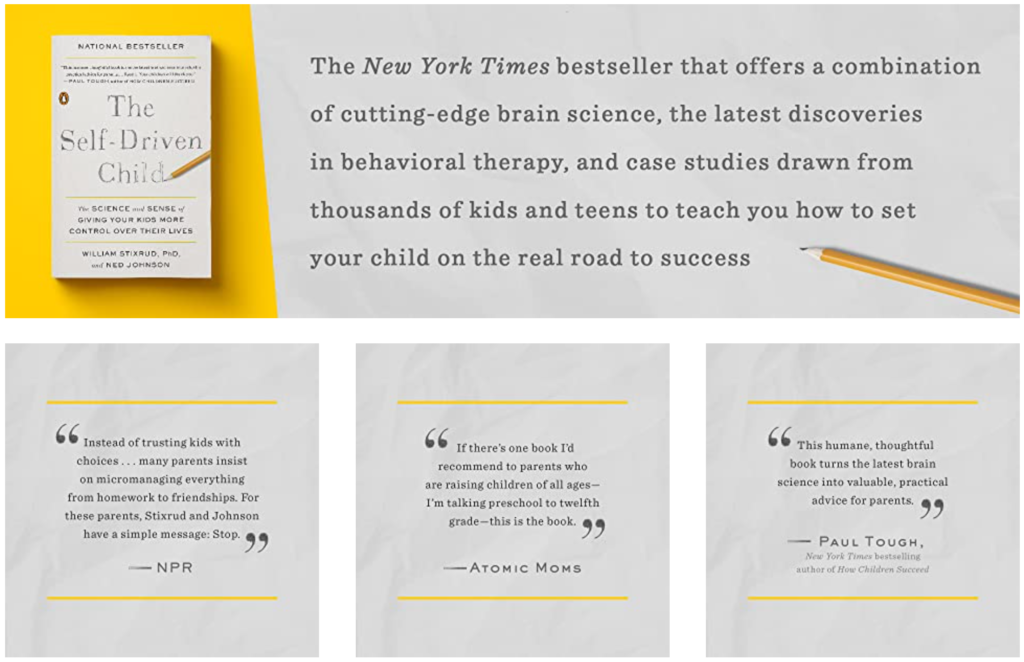
How to Raise a Self-Driven Child

The Self-Driven Child
The Science and Sense of Giving Your Kids More Control Over Their Lives by William Stixrud PhD & Ned Johnson
A Self-Driven Child will learn quickly and without much frustration when they are ready and interested. I believe agency over ourselves may be the most important factor in happiness and well-being, so I have done everything in my power to ensure that my kids have that. For our family, the academic goal of homeschooling has always been to inspire a love of learning. Relationships, mental health, and personal moral character always preceded academics for us. Children are curious by nature and want to learn!
With independence comes responsibility. Our children have been in charge of their own laundry, since they could reach the knobs with a step stool. It’s also up to them to ask for repairs or replacements. We don’t really buy much new, but when we do, it’s generally an emergency situation. Emergency situations are always stressful, even if it’s as small as a specific color shirt. We do our best to instill responsibility in our children to help them avoid those situations.

Book Review of The Self-Driven Child
Being the parent of a self-driven child can be challenging, but it also has its benefits. These children are often independent, goal oriented, and driven by their passions and goals. The Self-Driven Child, by William Stixrud PhD and Ned Johnson MD, delves into these tendencies and offers parents advice on how to deal with them, while also helping children harness their strengths as they become adults. If you’re interested in this topic or want to learn how to raise a self-driven child, here’s what you’ll find inside this book review of The Self-Driven Child.
What does self-directed learning mean?
Self-directed learning means that the child is in charge of learning. The child decides what is important and what will be learned and they have control over how, when and where to learn. A self-directed learner knows how to find information and make good decisions about what is worth spending time on.
Children who are not self directed depend on parents or teachers for direction in their learning. They may rely heavily on others to tell them what they should do, whether it is school work or play activities, or hey may have difficulty figuring out what interests them most, and so might end up doing tasks that don’t interest them at all just because someone else tells them to do it.
In this way, self-directed learners have more freedom to explore areas of their own interests. They also tend to be better learners, since they’re always trying new things and adapting to different situations. Finally, self-directed children develop stronger executive , which help them regulate their emotions and plan for the future. All these skills lead children to become more independent thinkers later in life.
General approach for a self-driving curriculum
The authors discuss why some parents may be drawn to this book and how the program works. They start with the basics of what it meant to be self-driven, and then move onto the benefits for children, including how it affects their social lives. They go into detail about how parents should respond when their child becomes self-driven, as well as what they should expect from their child in relation to friends, schooling and family life. The authors stress that a self-driven curriculum is much like any other typical homeschooling curriculum, in that it can be customized, with the exception being more emphasis on hands-on learning than is typically seen in public schools.
Start with age appropriate skills
As children grow, they will naturally develop their own interests and passions. This process is known as self-discovery. It can be hard for parents and teachers alike to let go of the idea of molding their child into what they think they should be, but it is important to get out of the way. Allow your child to explore their interests and work on them to reach their potential. If you help them, make sure you are not doing all the work for them or giving them an unfair advantage. Encourage them to persevere and figure things out for themselves, so they can learn from their mistakes.
The goal is that by the time your child becomes an adult, they will have developed life skills, such as creativity, problem solving skills, perseverance and grit. Children who are raised this way become individuals who are driven and creative thinkers. They know how to solve problems with minimal assistance from others, because they learned how to do this when they were young. Self-Driven children don’t need constant hand holding and supervision, which means they are often more independent than other kids of their age. These kids also feel comfortable taking risks, which leads to innovation and exploration. Unschoolers usually develop talents at a very young age, because if they want to learn something new, they find ways to teach themselves, rather than having someone else tell them how and when it’s done.
Children develop skills at different rates, so don’t panic if your child is not on track with their peers. There is no set time for each child to reach certain milestones; as long as they are developing at an age appropriate rate and have loving support from you, they will end up just fine. If there are some areas where your child struggles more than others, look for ways that you can boost their confidence. Children with high self-esteem generally develop better and feel more comfortable around other people.
When you allow your child to pursue their interests and take risks when they are ready, you will not only help them become self-driven, but you will also encourage them to have confidence in themselves. If they don’t develop these skills early on, it can be difficult for them later on in life.
Build independence from birth on
The first step in raising a self-driven child is to give the child enough time and space to figure out the world for themselves. This means letting your child explore and make their own discoveries, mistakes and successes without getting involved too much. In other words, you don’t have to be an expert on everything. It can also mean setting up opportunities for children to practice self-control early on. One example is not intervening when they’re trying to put together puzzles or other complicated toys. Rather than come in with suggestions or move their hands, it’s important that you let them struggle through it themselves, so they can learn how to solve problems themselves.
Another essential part of raising self-driven children is letting them experience failure. Failure is an important part of learning and can help build resilience. It’s good for your children to experience both minor and major setbacks, because it teaches them that they can overcome most problems with time, effort and patience. If you step in immediately when things go wrong, you take away your child’s ability to learn from their mistakes. This has long-term effects – when they grow up, they may have difficulty persevering in education or work due to a lack of coping skills.
Encourage your child’s curiosity
Allow them to explore and try new things. Be open and willing to answer any questions they may have, regardless of how silly they seem. Remember that while you are the one who knows the most about the world, your child has his or her own unique perspective, which may be equally valuable. Listen and take notes if you want to remember what they tell you!
Give your child space to make decisions: Letting go is tough for adults too, but it will only make you more loved in the long run. Give your children space to make their own decisions as often as possible, even when it doesn’t always work out well. It will help develop their self-confidence and increase their sense of responsibility for their actions.
Avoid educational pushover
There are two main concepts in Stixrud‘s book. One is that the child has the power and responsibility to make his or her own decisions, and that parents should not try to control them. The other concept is that children have innate talents, so it is up to their parents to help them discover what those talents are, and then find ways to use them. These two concepts will be vital for raising a self-driven child.
Ultimately, this approach will produce well-rounded individuals who know how to motivate themselves. They will know when to push through hard work and when to step back. They also won’t have anything to prove, since they’ve found success on their own terms.
Buy the Book
This book, written by Dr. William Stixrud and Ned Johnson, is about how parents can raise their children with self-driven motivation. This book is great for people who have a child with an independent streak and don’t like being told what to do or having their hand held all the time. The authors believe this style of parenting will lead to more motivated kids with more confidence. I think this style of parenting is right in line with unschooling, but comes at it from a schooling perspective. If you want your child to grow into a happy and well-adjusted adult, then this book may be worth looking into!



